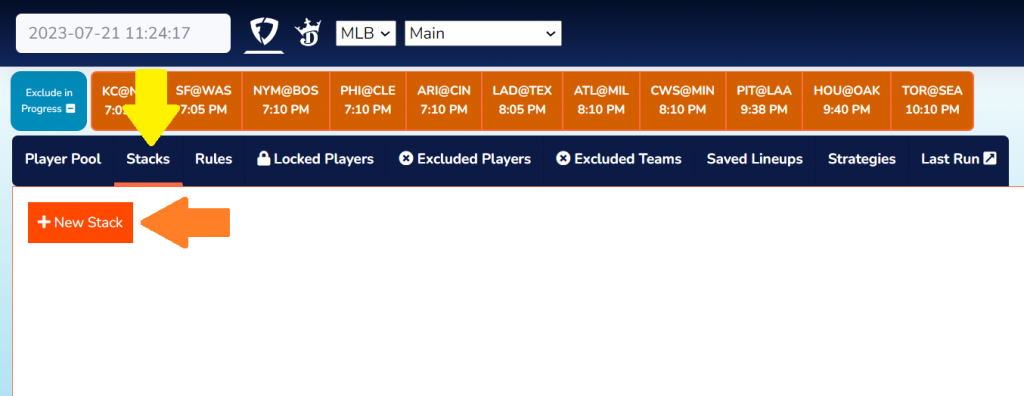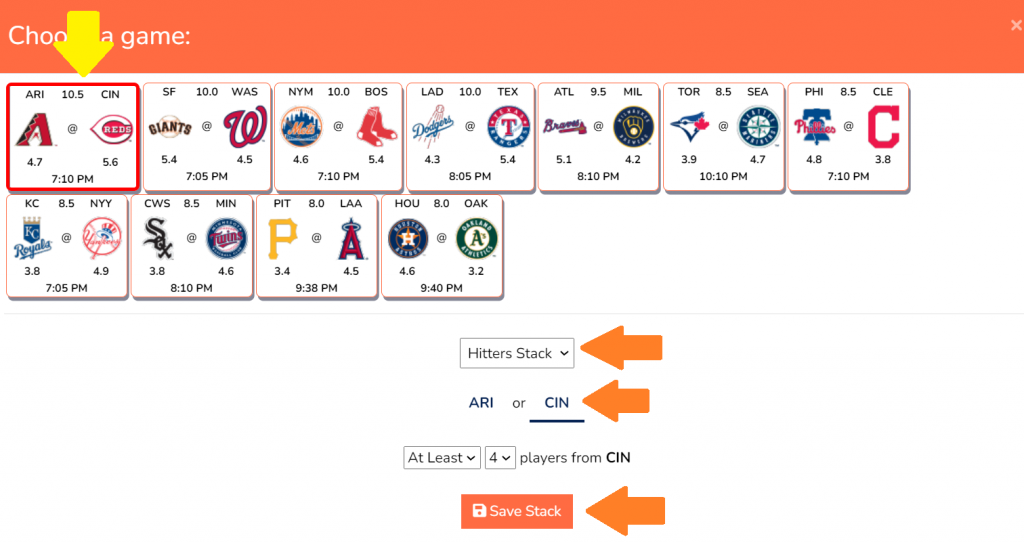What is stacking?
Stacking in DFS, refers to selecting two or more players from the same team or game based on the belief that they have a positive correlation. The most common type of stack is the QB/Receiver stack, where you choose a quarterback and one of his receivers to be on your fantasy team. The rationale behind stacking is to increase your upside potential. If one of the stacked players has a strong performance, there’s a high likelihood that the other player will benefit from it as well. For instance, if the quarterback throws a touchdown pass, the receiver who catches it earns points too, amplifying your score.
However, stacking also comes with increased downside risk. If one of the stacked players has a poor game, it’s likely that the other player’s performance will also suffer. For example, if the quarterback throws interceptions, it negatively impacts the receiver’s chances of getting valuable receptions or touchdowns, potentially lowering your overall score. Experienced fantasy sports players often use stacking as part of their overall lineup strategy, but it should be done thoughtfully and with a good understanding of the teams, players, and matchups involved.
Let’s go over the different types of stacks for the different sports.
NFL
QB/Receiver
Every receiving touchdown for a receiver is also a throwing touchdown for his quarterback. And every receiving yard is also a passing yard for the quarterback. For that reason, the quarterback/receiver positions are the most highly correlated positions in all of sports.
QB/Receiver/Opposing Receiver
If a quarterback and his receiver are having a good game, there’s a strong chance that the opposing team is playing from behind. When teams play from behind, they typically abandon the run game and resort to the passing game. Not only that, but a lot of the time, if a team is ahead, they’ll play a soft coverage defense. This means that they’ll give up a lot of underneath passes. As a result, a lot of times, if a quarterback and receiver have a big game, there might be a receiver on the other team that also goes off. This is why the QB/REC/OPP REC is such a popular stack in the NFL.
QB/Receiver/Receiver (AKA the Double Stack)
This stack involves selecting a QB and two of his receivers. The thought process here is that the quarterback has a huge game and spreads the ball around to these two receivers. However, you have to acknowledge the fact that the two receivers on the same team are negatively correlated. Every target one receiver gets is a target that the other receiver does not get. There are occasions, however, when this pays off. My biggest win last season was Week 2 when I stacked Tua/Tyreek/Waddle.
QB/Receiver/Receiver/Opposing Receiver (AKA the Triple Stack)
The thought process behind this type of stack is that a particular game becomes a high scoring, ariel affair where both teams wrack up the receiving yards and simultaneously abandon the run game. These types of games usually occur when two elite quarterbacks are going up against eachother.
RR/DEF
This is another popular stack for the NFL, even though the correlation isn’t nearly as strong as that of a QB/Receiver. The thought process is that a team takes an early lead and runs the ball the rust of the game, chewing up clock and denying the other team’s offense the ability to put up points. If they take a big enough lead, the other team can get desperate and start turning the ball over.
MLB
Hitters Stack
Stacking a bunch of hitters from the same team is almost essential if you want to take down a big tournament. Hitters from the same team are positively correlated for multiple reasons. If a hitter gets an RBI, that means someone from that team also got a run. Also, the more hits a player gets, the more at bats his teammates will get. Furthermore, if a team is getting a bunch of runs early on, the opposing team might pull their starting pitcher and go their bullpen, where the quality of pitching isn’t nearly as strong.
NBA
Big/Little Stack
Stacking in the NBA isn’t quite as popular as in other sports. This is because NBA teammates are typically negatively correlated. However, if you take a big and a little (ie a PG and a C) from the same team, those two players have a chance at being positively correlated. That’s because 1) typically a big and a little aren’t competing for minutes, and 2). they’re not competing for rebounds or assists.
Game Stacks
When you have a smaller NBA slate, such as a 3-game slate, sometimes stacking one particular game is a smart move. This may be because you expect this game to be competitive and high scoring, while you expect the other two games to be blowouts. Or maybe you think that this game has the potential to go to overtime.
EPL Soccer
Team Stacks
Stacking is almost as important in soccer as it is in baseball and football. This is because a lot of the time, soccer players from the same team are positively correlated. For instance, if a team shuts out the other team, all of the players on that defense will get fantasy points for a “clean sheet”. The goalie will also get points for the clean sheet, and also for the win. The goalie also won’t have any points deducted for any goals scored on him if they shut the other team out.
Also, if one player gets an assist, that means there’s someone on the receiving end of that who gets a goal. Assists and goals are gamebreakers in fantasy soccer. Even further, a lot of times, when a team takes the lead in soccer, the opposing team will become more aggressive, thus leaving their defense vulnerable for more goals.
How to Stack with our Optimizer
We make stacking as simple as possible. Simply navigate to the “Stack” tab and hit the “New Stack” button. Once you do that, all of the games will appear, in order from highest projected points total to lowest projected points total. Simply choose a game and our stack tool will prompt you for the rest.


You can also assign the optimizer with more than one stack, as shown below:

You can remove a stack by hitting the “undo” button to the left of the stack description:

